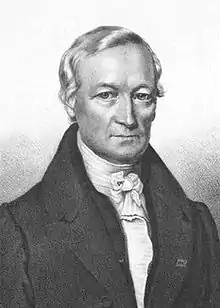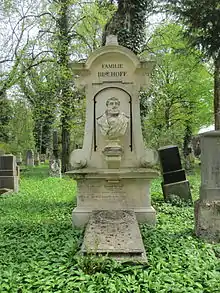Friedrich Tiedemann
Friedrich Tiedemann FRS HFRSE (23 August 1781 – 22 January 1861) was a German anatomist and physiologist. He was an expert on the anatomy of the brain.
Friedrich Tiedemann | |
|---|---|
 Tiedemann in 1820 | |
| Born | 23 August 1781 |
| Died | 22 January 1861 (aged 79) |
| Nationality | German |
| Scientific career | |
| Fields | Anatomy |
| Doctoral advisor | Johann Wilhelm Christian Brühl[1] |
| Other academic advisors | Conrad Moench Georg Wilhelm Stein Adalbert Friedrich Marcus Karl Kaspar von Siebold Franz Kaspar Hesselbach Georges Cuvier |
| Influences | Friedrich Wilhelm Joseph Schelling Samuel Thomas von Sömmerring |
| Signature | |
Tiedemann spent most of his life as professor of anatomy and physiology at Heidelberg, a position to which he was appointed in 1816, after having filled the chair of anatomy and zoology for ten years at Landshut, and died at Munich.[2] He was elected member of the Royal Swedish Academy of Sciences in 1827. In 1836, he was elected Honorary Fellow of the Royal College of Surgeons in Ireland.[3]
Life
Tiedemann was born at Cassel in Prussia (now central Germany), the eldest son of Dietrich Tiedemann (1748–1803), a philosopher and psychologist of considerable repute.
Friedrich studied Medicine at Marburg, Bamberg and Würzburg Universities from 1798 and graduated in 1802. Undertaking practical experience he gained his doctorate (MD) from Marburg in 1804, but soon abandoned practice.[2]
From 1804 he became a Docent, lecturing in Physiology and Comparative Osteology at Marburg University. In only one year (1805) he was raised to Professor aged only 24. This was as Professor of Zoology, Human Anatomy and Comparative Anatomy at Landshut University. In 1816 he moved to Heidelberg University as Professor of Physiology and Anatomy and remained there until retiring in 1849.[4]
He was elected a Foreign Fellow of the Royal Society of London in 1832 and an Honorary Fellow of the Royal Society of Edinburgh in 1838.
He died in Munich on 22 January 1861. He is buried in the Alter Südfriedhof in Munich (Old South Cemetery).
Viewpoints

Tiedemann devoted himself to the study of natural science, and, upon moving to Paris, France, became an ardent follower of Georges Cuvier. On his return to Germany he maintained the claims of patient and sober anatomical research against the prevalent speculations of the school of Lorenz Oken, whose foremost antagonist he was long reckoned. His remarkable studies of the development of the human brain, as correlated with his father's studies on the development of intelligence, deserve mention.[2]
Tiedemann was one of the first persons to scientifically contest racism. In his article entitled "On the Brain of the Negro, compared with that of the European and the Orang-outang" (1836), he argued based on craniometric and brain measures taken by him from Europeans and black men from different parts of the world that the then-common European belief that Negroes have smaller brains and are thus intellectually inferior is scientifically unfounded and based merely on the prejudice of travellers and explorers.[5][6][7]
In 1827 he became correspondent of the Royal Institute of the Netherlands, when that became the Royal Netherlands Academy of Arts and Sciences in 1851 he joined as foreign member.[8] He was elected a Foreign Honorary Member of the American Academy of Arts and Sciences in 1849.[9]
Tiedemann was influenced by Jean-Baptiste Lamarck and accepted the transmutation of species.[10] Science historian Robert J. Richards has written that Tiedemann "joined the basic notion of species evolution, of a Lamarckian flavor, with the proposition that higher animals in their embryological development recapitulated the morphological stages of those lower in the scale."[11] Hans Gadow however noted that Tiedemann had identified several of elements of Darwinian evolutionary theory in 1814.[12]
By the 1860s, the tobacco historian Friedrich Tiedemann had reported several cancers of the tongue brought on by smoking.[13]
Family
In 1807 he married Frauline von Holzing. He was later married to Charlotte Hecker.
He had a daughter Elise.
One of Tiedemann's sons, Gustav, was a casualty of the 1848 uprisings.[14]
His son Heinrich immigrated to Philadelphia and became a physician in Philadelphia's Germantown Hospital. Perhaps influenced by his father's work, he objected to the Darwinian contention of a continuity between humans and apes.[15]
Legacy
In 2007, Brazilian geneticist Sergio Pena called Tiedemann an "anti-racist ahead of his time".[16]
Works
Translated :
Tiedemann, Friedrich Friedrich Tiedemann's Anatomy of Headless Abortions: along with four copper plates Landshut, 1813 Tiedemann, Friedrich Anatomy and history of the brain's formation in the fetus of man, together with a comparative account of the structure of the brain in the animals Nuremberg, 1816 New Tiedemann, Friedrich Friderici Tiedemann Anatomists Et Physiologiae in Academia Heidelbergensi Professoris Icones Cerebri Simiarum Et Quorundam Mammalium Rariorum Heidelberg, 1821 Tiedemann, Friedrich Friderici Tiedemanni Tabulae arteriarum corporis humani / Friederich Tiedemann's Illustrations of the arteries of the human body (explanations) Karlsruhe, Heidelberg, 1822 Tiedemann, Friedrich Friderici Tiedemanni Tabulae arteriarum corporis humani / Friederich Tiedemann's Illustrations of the arteries of the human body (panels) Karlsruhe, Heidelberg, 1822 Tiedemann, Friedrich; Gmelin, Leopold Some new constituents of bile of the ox Leipzig, 1827 Tiedemann, Friedrich Anufuf to the humanity of the higher authorities of justice care in Germany, caused by a beheaded on October 22, 1827 in Heidelberg beheading Darmstadt, 1829 Tiedemann, Friedrich The Negro's Brain Compared With The European And Orang-Outang: With Six Panels Heidelberg, 1837 Tiedemann, Friedrich Of the Duverneyschen, Bartholin's or Cowper's glands of the woman, and the oblique shape and position of the uterus: With four panels of illustrations Heidelberg, Leipzig, 1840
References
- Neurotree profile Friedrich Tiedemann
- Chisholm 1911.
- "Archived copy". Archived from the original on 3 February 2018. Retrieved 4 August 2016.CS1 maint: archived copy as title (link)
- Biographical Index of Former Fellows of the Royal Society of Edinburgh 1783–2002 (PDF). The Royal Society of Edinburgh. July 2006. ISBN 0-902-198-84-X.
- Tiedemann, Friedrich (1836). "On the Brain of the Negro, compared with that of the european and the orang-outang" (PDF). Phil. Trans. 126: 497. Bibcode:1836RSPT..126..497T.. Tiedemann was heavily criticized in medical journals at the time, including by Andrew Comb, Remarks on the Fallacy of Professor Tiedemann, Eclectic Journal of Medicine (1838).
- Mitchell, P.W. (2018). "The fault in his seeds: Lost notes to the case of bias in Samuel George Morton's cranial race science." Public Library of Science Biology 16 (10): e2007008.
- Mitchell, P.W. and Michael, J.S. (2019). "Bias, Brains, and Skulls Tracing the Legacy of Scientific Racism in the Nineteenth-Century Works of Samuel George Morton and Friedrich Tiedemann" In Jackson, Christina, and Thomas, Jamie (eds.). Embodied Difference: Divergent Bodies in Public Discourse. Lanham, MD: Rowman and Littefield. p. 77-98. ISBN 978-1-4985-6386-4. Retrieved 2019-07-26.
- "Friedrich Tiedemann (1781–1861)". Royal Netherlands Academy of Arts and Sciences. Retrieved 20 July 2015.
- "Book of Members, 1780–2010: Chapter F" (PDF). American Academy of Arts and Sciences. Retrieved 9 September 2016.
- Ruse, Michael; Travis, Joseph. (2009). Evolution: The First Four Billion Years. Belknap Press. p. 442. ISBN 978-0674062214
- Richards, Robert J. (2008). The Tragic Sense of Life: Ernst Haeckel and the Struggle over Evolutionary Thought. University Of Chicago Press. p. 466. ISBN 978-0226712161
- Gadow, H. (1913). "Darwinism 100 Years Ago". Nature. 92 (2298): 320. Bibcode:1913Natur..92..320G. doi:10.1038/092320a0. S2CID 3988649.
- Proctor, R.N. Tobacco and the global lung cancer epidemic. Nature. October 2001, 1(1):82–86.
- Koenig, Robert. (2009). The Fourth Horseman: The Tragedy of Anton Dilger and the Birth of Biological Terrorism. Tantor Media. p. 21. ISBN 978-1400153503
- Tiedemann, Heinrich. (1876). Mensch und Affe: eine Vorlesung welche am 3. Februar 1876 in der Halle der Teutschen Gesellschaft zu Philadelphia gehalten wurde. German Society of Philadelphia.
- Pena, Sergio (2007). "Um anti-racista à frente de seu tempo". Ciencia Hoje. Instituto Ciencia Hoje. Retrieved 6 April 2013.
Um anti-racista à frente de seu tempo
- Attribution
![]() This article incorporates text from a publication now in the public domain: Chisholm, Hugh, ed. (1911). "Tiedemann, Friedrich". Encyclopædia Britannica (11th ed.). Cambridge University Press.
This article incorporates text from a publication now in the public domain: Chisholm, Hugh, ed. (1911). "Tiedemann, Friedrich". Encyclopædia Britannica (11th ed.). Cambridge University Press.